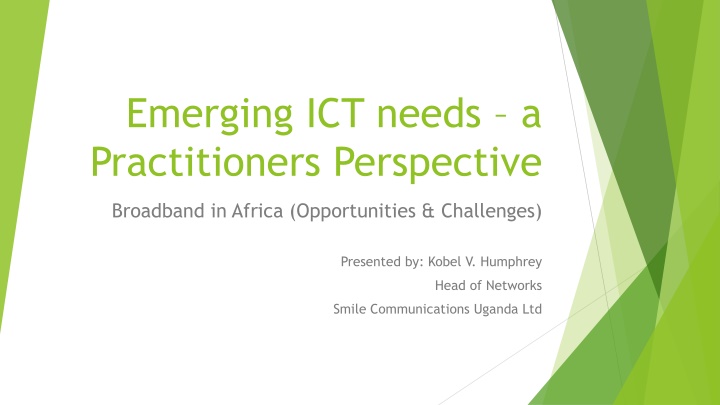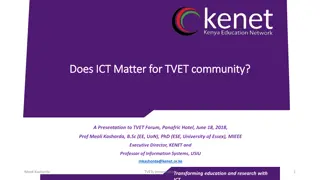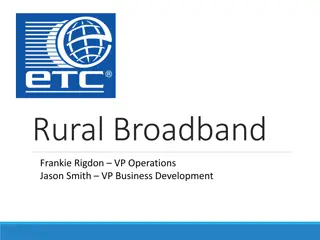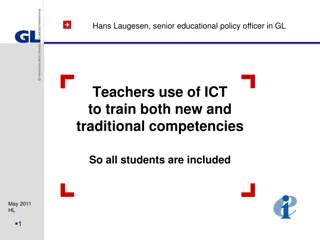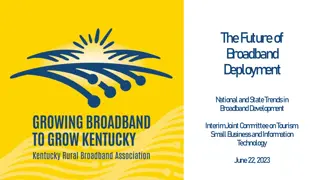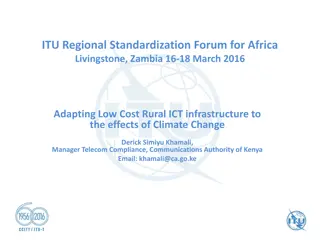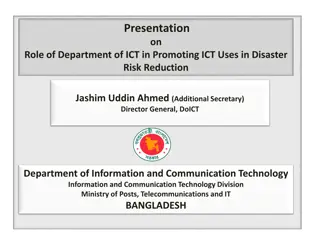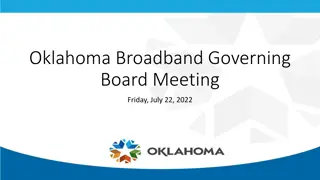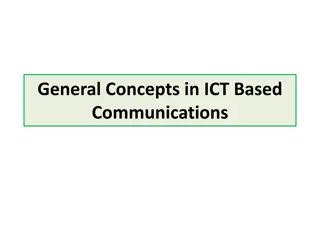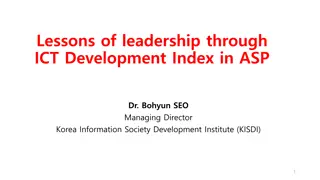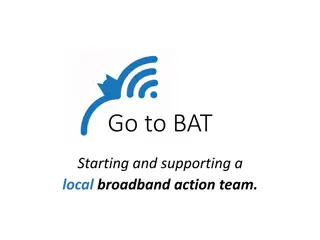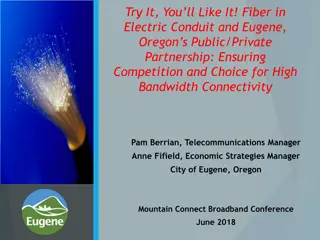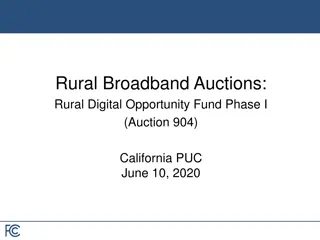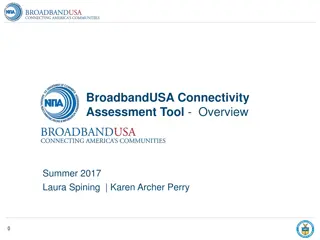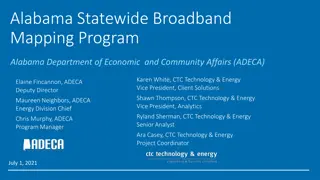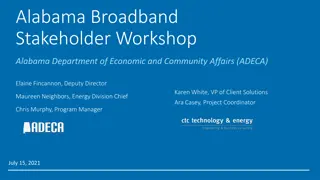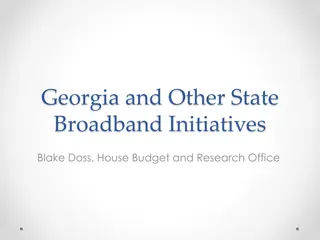Emerging ICT Needs in Africa: Broadband Opportunities & Challenges
Telecommunications enables voice and data communication, with technology enhancing delivery methods. Broadband demand is increasing in Africa, driven by factors like higher bandwidth and network efficiencies. The evolution to 4G LTE presents opportunities for improved services and market growth in the region.
Download Presentation

Please find below an Image/Link to download the presentation.
The content on the website is provided AS IS for your information and personal use only. It may not be sold, licensed, or shared on other websites without obtaining consent from the author.If you encounter any issues during the download, it is possible that the publisher has removed the file from their server.
You are allowed to download the files provided on this website for personal or commercial use, subject to the condition that they are used lawfully. All files are the property of their respective owners.
The content on the website is provided AS IS for your information and personal use only. It may not be sold, licensed, or shared on other websites without obtaining consent from the author.
E N D
Presentation Transcript
Emerging ICT needs a Practitioners Perspective Broadband in Africa (Opportunities & Challenges) Presented by: Kobel V. Humphrey Head of Networks Smile Communications Uganda Ltd
Introduction Telecommunications is an enabler to deliver services: Voice communication Data communication (Messaging, internet, email, private leased circuits, etc.) The rest is Technology How BEST to Deliver. Technology Advantages (efficiencies, speed, costs, security, etc.). Limiting factors Availability of the technology (coverage, fibre foot print, etc.) Growing Demand to Transmit Higher Data Volumes: Voice has not changed much in centuries. Growing demand for higher data speeds is driving technological innovation. Broadband (Remains an Evolving Market Demand) ITU Standardization Sector defines Broadband as a Transmission Capacity that is faster than 1.5 Mbps or 2.0 Mbps .
Broadband in Africa Broadband, Driving Factors: Higher Bandwidth (Increasing Throughput Speed of Data Transfer) Quality of Service (for High Definition Services, e.g. HD Voice, HD Video, etc.) Lower Latency (faster response times from the Network, e.g. Call setup times) Network Efficiencies (Higher Network Capacity & Quality limited Resources) 4G LTE & Broadband What Advantages does 4G have over 3G? The simple answer is that a 4G-LTE network will have a higher data transfer rate, with better network efficiencies. Benefits Beyond Speed: Better Audio Quality CS networks offer narrow band Vs 4G wide-band audio. Unified Communication & Collaboration Presence, Chat, Video Conferencing. Improved Network Administration Dynamic & Efficient Sharing of IP Resources.
4G LTE Opportunity for Broadband Technology Opportunities: Support for HD Services (Voice over LTE - VoLTE, Video over LTE - ViLTE, End-to- End QoS Management, Guaranteed Bit Rates GBR, etc). Improved Network Efficiencies for Higher Speed, Capacity & Quality: Spectrum Efficiency (60 Mbps, using 10MHz - FDD & 120Mbps with Carrier Aggregation). Increased DL, UL & Cell-Edge Throughput (Adaptive Modulation, MIMO, Rx Diversity). Lower Latency from reduction of network nodes. Self Optimised Networks (ANR, Faster UE Cell Reselection Saves Dropped Calls, etc.) Voice Service Continuity (CSFB to 3G and 2G Networks). Longer Battery Life for Users LTE RAN is Designed for numerous Spectrum Band Plans, with Multi-Carrier Support in Base Band Unit (BBU). Band 20 (800 MHz) and Band 7 (2600 MHz) adopted for Africa. Ref: Annexure A Detailed LTE Band Plans (for FDD and TDD).
4G LTE Opportunity for Broadband Market Opportunities: Low Penetration Opportunity for Growth Sub-Saharan Africa has the lowest mobile penetration, with 12% CAGR in 2014. Rapid Shift to Mobile Broadband expected by 2020 (GSMA). http://www.gsmamobileeconomy.com/GSMA_Global_Mobile_Economy_Report_2015.pdf
4G LTE Opportunity for Broadband Market Opportunities: Handset Costs Still to Come Down: Biggest Barrier to Entry of 4G LTE (Handsets Cost ~ US$ 100 US$ 700). The Sweet-Spot in pricing, expected to be between ~ US$ 25 US$ 50, for Africa. Handset Manufacturers are already working to meet this goal. http://www.gsmamobileeconomy.com/GSMA_Global_Mobile_Economy_Report_2015.pdf 4G LTE Handsets Expected to more than double in 3 Years (by 2018). http://www.statista.com/statistics/503375/4g-lte-mobile-phones-in-use-worldwide/
4G LTE Challenges Challenges to Overcome: Developing Business Case in a Mature, Competitive Market from GSM. High Network Rollout Costs (Expensive New Network Technology). Low Market Uptake (Expensive Handsets) but Promising Growth Slow Coming Profitability Constraining Aggressive Rollout: Biggest Value Driver for Mobile Network Growths is Coverage. Competitive Product Positioning (4G-LTE Data Vs 3G & 2G Data Price Sensitivity). Transmission Infrastructure Limitations: High LTE throughput per Site Demands High Transmission Bandwidth (10s -100s Mbps) Limited Fibre Optic Footprint - Microwave transmission is limiting for Backhaul. Consumer Literacy Adapting to Higher 4G-LTE Speeds, New Charging Models, etc. Local Content for Broadband & Internet Consumption Expensive IBH. LTE Standardization, Government Policy (Licensing, Regulation, Legislation, etc.). Require Adoption for Broadband Presently tailored Around Traditional 2G Models.
Thank You The End Any Questions??
Annexure A FDD Spectrum, 1/2 FDD LTE Bands & Frequencies Duplex Spacing (MHz) 190 LTE Band Uplink Downlink Width of Band (MHz) Band Gap (MHz) Number 1 (MHz) 1920 - 1980 (MHz) 2110 - 2170 60 130 2 1850 - 1910 1930 - 1990 60 80 20 3 1710 - 1785 1805 -1880 75 95 20 4 1710 - 1755 2110 - 2155 45 400 355 5 824 - 849 869 - 894 25 45 20 6 830 - 840 875 - 885 10 35 25 7 2500 - 2570 2620 - 2690 70 120 50 8 880 - 915 925 - 960 35 45 10 9 1749.9 - 1784.9 1844.9 - 1879.9 35 95 60 10 1710 - 1770 2110 - 2170 60 400 340 11 1427.9 - 1452.9 1475.9 - 1500.9 20 48 28 12 698 - 716 728 - 746 18 30 12 13 777 - 787 746 - 756 10 41 -31 -30 700 14 788 - 798 758 - 768 10 40 15 1900 - 1920 2600 - 2620 20 680 16 2010 - 2025 2585 - 2600 15 575 560
Annexure A FDD Spectrum, 2/2 FDD LTE Bands & Frequencies Duplex Spacing (MHz) 30 LTE Band Uplink Downlink Width of Band (MHz) Band Gap (MHz) Number 17 (MHz) 704 - 716 (MHz) 734 - 746 12 18 18 815 - 830 860 - 875 15 45 30 19 830 - 845 875 - 890 15 45 30 20 832 - 862 791 - 821 30 71 -41 48 21 1447.9 - 1462.9 1495.5 - 1510.9 15 33 22 3410 - 3500 3510 - 3600 90 100 10 23 2000 - 2020 2180 - 2200 20 180 160 24 1625.5 - 1660.5 1525 - 1559 34 135.5 -101.5 80 25 1850 - 1915 1930 - 1995 65 15 26 814 - 849 859 - 894 30 / 40 10 27 807 - 824 852 - 869 17 45 28 28 703 - 748 758 - 803 45 55 10 29 n/a 717 - 728 11 30 2305 - 2315 2350 - 2360 10 45 35 31 452.5 - 457.5 462.5 - 467.5 5 10 5
Annexure A TDD Spectrum TDD LTE Bands & Frequencies LTE Band Allocation (MHz) Width of Band (MHz) Number 33 1900 - 1920 20 34 2010 - 2025 15 35 1850 - 1910 60 36 1930 - 1990 60 37 1910 - 1930 20 38 2570 - 2620 50 39 1880 - 1920 40 40 2300 - 2400 100 41 2496 - 2690 194 42 3400 - 3600 200 43 3600 - 3800 200 44 703 - 803 100 Ref: http://www.radio-electronics.com/info/cellulartelecomms/lte-long-term- evolution/lte-frequency-spectrum.php
